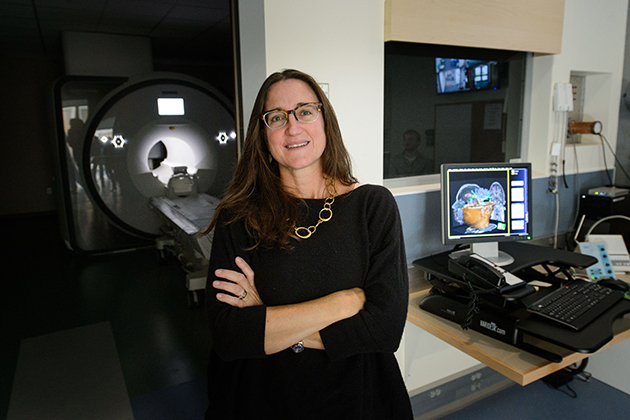At UConn, brain science isn’t just for professors – it’s also for undergraduates like Allison Fitch ’13 (CLAS), whose original research identified key components of how children can grow out of a diagnosis of autism. It’s all part of mounting momentum in cognitive science, where people are asking: How does our brain actually work?
As a sophomore studying psychology and human development, Allison Fitch ’13 (CLAS) realized that if she wanted to do graduate studies in psychology, she’d have to spend at least two years doing research as an undergraduate.

She wasn’t sure she was going to like it, but she was intrigued by the work of Inge-Marie Eigsti, associate professor of psychology, whose work focused on how some teenagers diagnosed with autism in early childhood had reached “optimal outcomes” by effectively growing out of their symptoms. The work built on the groundbreaking research of UConn Board of Trustees Distinguished Professor Deborah Fein, as part of the National Institutes of Mental Health-funded Optimal Outcomes project.
Fitch was also drawn to the study for more personal reasons. She’d grown up with a younger brother who didn’t start speaking until he was almost four years old, and was curious to learn more about the relationship between communication and cognitive function: a concept that would eventually shape her career.
The big picture and the small picture
Fitch began transcribing videotapes and logging behavioral data as part of Eigsti’s cognitive science research team. Her job was to record the number of words young study subjects used to verbally describe oil paintings while under “cognitive load,” a scientific term for multitasking, which in this case meant children tapping a computer keyboard with their index finger as they spoke.
She began to notice a pattern that didn’t involve word counts. The children seemed to fall into two categories: those who focused almost solely on small details in the paintings, and those who viewed them as overall images or scenes. And that made her wonder how having a brain disorder like autism might affect a person’s understanding of details, so she asked Eigsti if she could use the data to design a study of her own.
Eigsti agreed, and Fitch went on to show that children who overcame their autism diagnosis were similar to typically developing children in recognizing the big picture when looking at art, while children with autism were more interested in the smaller details. This corroboration of Fein’s theory suggested that overcoming an autism diagnosis involves changes at the level of cognitive processing.
As a result of her work, Fitch developed a passion for research. She also received an invitation to speak about her findings at the International Meeting for Autism Research in Spain, and published a peer-reviewed article as first author – both rare accomplishments for an undergraduate.
“This fantastic undergraduate took it upon herself to ask if she could independently pursue work that adds to the data showing how kids with autism tend to focus on the details of things and really struggle to understand, and express, the bigger picture,” says Eigsti.
She says Fitch’s work is crucial to educational settings. For example, a teacher assigning a book report will know that a child with autism is going to need extra help understanding the assignment in its entirety, but probably won’t need so much help with each step.
“There’s so much clinical relevance to what Ally’s done,” Eigsti says.
A new research tool
As part of the second phase of the Optimal Outcomes study, Eigsti and her team of students are now working to better understand the mechanical changes in the brain related to cognition that occur in children who, as they grow up, lose autism symptoms. They’ll also be researching gestures and other forms of nonverbal communication in children with autism spectrum disorders; and will look at how having difficulties making generalizations affects children’s behavior and learning.

Working with psychology professor Edward Large, Eigsti will also examine how autism and savant skills impact music cognition – an area about which very little is known.
These projects will use the advanced brain Functional Magnetic Resonance Imaging machine (fMRI) that UConn purchased earlier this year, which shows in real time what portions of the brain are involved in cognitive tasks. The scanner is the centerpiece of the College of Liberal Arts and Sciences’ newly established Brain Imaging Research Center.
Funded by nearly $10 million in grants, and in development for more than three years, the Center is a result of UConn’s Academic Vision plan, which outlines the University’s pursuit of excellence in undergraduate education, graduate study, teaching, engagement, and research.
Establishing UConn and the College of Liberal Arts and Sciences as a center for language and cognition was also part of that plan – something Fitch says she had the benefit of experiencing even before it was fully in place.
Fitch transferred to UConn in her sophomore year because of the opportunities the University offered to undergraduates – especially in doing research – that were not available elsewhere.
She is now in her third year working toward a doctorate in developmental and brain sciences at the University of Massachusetts, Boston, and she credits her success to those first days at UConn when she started doing research.
“Getting the OK to perform my own research, being asked to speak at an international conference … it was all very frightening at first,” Fitch remembers. “But then I realized, ‘These people see something in me.’
“Brain cognition is such a fascinating and important field,” she adds, “and being a UConn student led me there.”


